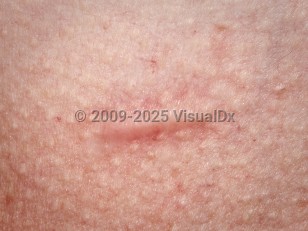The various types of scars that exist can be divided into the following categories.
Scars Following Inflammatory Processes and Infectious Disease
Many inflammatory processes can cause scar formation, and diseases that frequently cause scars are:
Acne scars
Particular forms of inflammatory acne may result in permanent scar formation, which is problematic for both the patient and the doctor treating the condition.
Acne scars are varied and include ice-pick, rolling, boxcar, hypertrophic, keloidal, and papular morphologies.
Varicella scars
The prevalence of scarring following varicella (chickenpox) infection was found to be around 18% in one study. The scars were mostly located on the face, followed by the chest, abdomen, and back.
The lesions may be hyperpigmented or hypopigmented, and may be depressed or hypertrophic.
Lupus erythematosus scars
Scarring is especially prevalent following discoid lupus erythematosus. Scars follow the erythematous scaly plaques and can manifest as hyperpigmented or hypopigmented patches, atrophic scars, pitting scars, cribriform scarring, and scarring alopecia.
Factitial (self-induced) scars
Many pruritic skin disorders are associated with chronic excoriation by the patient. Patients carrying the diagnoses of neurodermatitis, neurotic excoriations, and prurigo nodularis frequently have scars from severe self-picking and gouging of the skin.
Scars Following External Trauma and Injury to the Skin
- Hypertrophic scars
- Keloids
- Atrophic scars
Hypertrophic scars are raised, nodular, red growths that continue to increase in size for up to a year, a longer period of time than normal scars but still less than that of keloids. Hypertrophic scars remain confined to the edges of the original wound even though they may appear to have overgrown it.
Keloids initially produce scar tissue that is less proliferative compared to hypertrophic scar tissue, but since they continue to grow beyond the time frame of hypertrophic scars, they end up producing more scar tissue. Keloids occur more frequently in people with darker skin colors, and African Americans have a fivefold increased tendency to develop keloids.
Scarification refers to a custom in some African cultures involving the intentional burning or cutting of the skin to produce scars. Keloid formation is often the desirable end point. See cultural practices for more information.
Commonly Seen Injury-Related Scars
Sternotomy scars
Most cardiac surgical procedures, such as coronary artery bypass surgery, congenital heart defects repair, and cardiac transplant, are performed using a median sternotomy as the preferred incision. These scars follow the lines of incision and closure and are often frequently pruritic.
Knee surgery scars
Incision scars associated with total knee arthroplasty can be of 2 types: medial parapatellar and midline. Arthroscopic incisions can also result in hypertrophic scars.
Biopsy scars
Erythema and hypertrophic scarring may follow a punch biopsy.
Mastectomy scars
There may be locoregional recurrence of carcinoma at the site of the scar, so these scars should undergo routine histological analysis.
Striae gravidarum
Striae (stretch marks) are a form of scarring and are atrophic linear plaques that develop due to stretching of the skin as seen in pregnancy and in childhood during periods of accelerated growth.
Burn scars
Burns usually leave behind scars that are hypertrophic.
Scars That Change Their Nature over the Passage of Time
Postvaccination smallpox scars
In 1980, the World Health Organization (WHO) declared that smallpox as a naturally occurring disease had been eradicated after a global immunization campaign. The United States ended routine smallpox vaccination for the general public in 1972 but continued military vaccination programs through 1990. After the terrorist attacks of September 11, 2001, and the anthrax letter attacks that followed, the United States resumed immunizing some military personnel, including some health care workers.
Vaccination site changes include the formation of keloids and, rarely, the formation of basal cell carcinoma and squamous cell carcinoma at the site. Squamous cell cancers occur between 25 and 40 years following vaccination.
Burn scars
Burn scars have been reported as developing malignant changes in the scar over the course of time. Mostly squamous cell carcinomas develop, although basal cell carcinoma and malignant melanoma have also been reported. Patients with burn scars should be monitored over time for the possibility of a squamous cell carcinoma.



 Patient Information for
Patient Information for 
